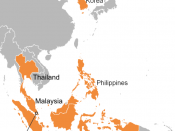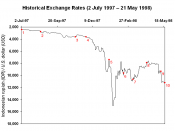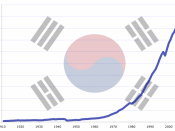Research on Money and Banking (Korean Financial Crisis Diagnosis and Prescription) Contents Causes of Crisis : A Partial Picture The Accumulation of Currant Account Deficits and the Control of Exchange Rate Why Did Foreign Investors Retreat? Is the Fundamental of Korean Economy Strong? Is the Open Market Bad? Chaebol Issue Is the Rise in Exchange Rate Bad What Do We Say of the Governmental Policy? What to Think of the IMF Rescue Package? What Are We to Do? References 1. Causes of Crisis : A Partial Picture Skyrocketing exchange rate, interest rates and the record low share prices have been shaking the whole Korea. The exchange rate of Korean currency (the Won) against U.S. Dollar has jumped more than twice from 861 as of Jan. 1997 to 1,737 as of Dec. 15. Market interest rate rose from 12.2% to 20.1% during the same period. Share prices index fell from 670 to 386.
Direct causes of the current crisis seem to be three fold; the accumulation of bad debts due to the increases in bankrupt firms; the resulting credit crunch; and the financial crisis in South East Asian countries like Thailand, Indonesia and Malaysia.
When banking institutions hold a lot of dishonored loans, it troubles the liquidity of the whole economy. They get loans from people that want the interest, and lend it to people who want to spend the money with interest.
Dishonored loans dampen the credibility of the bank, lowering the bank's ability to get additional loans since nobody would want to loan money or to deposit money in a shaky banking institution. When it can's get loans, it can't give loans, resulting in financial crisis.
One of the biggest causes of the dishonored loans the banking institutions came to hold is the bankrupt firms that owe them large...


